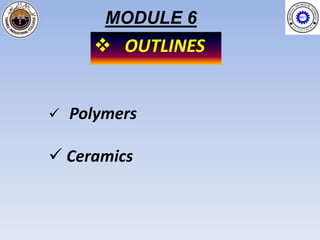
Met 402 mod-6
- 1. MODULE 6 OUTLINES Polymers Ceramics
- 2. Why Plastics? Plastic products can be mass-produced & require less skilled staff. Light weight, high weight to strength ratio, particularly when reinforced Relatively low cost compared to metals & composites Corrosion resistance & generally waterproof Plastics require little or no finishing, painting, polishing etc Low electrical and thermal conductivity, insulator Easily formed into complex shapes, can be formed, casted & joined. Wide choice of appearance, colors and transparencies
- 3. Disadvantages of using Plastics Low strength Low useful temperature range Less dimensional stability over period of time (creep effect) Aging effect, hardens and become brittle over time Sensitive to environment, moisture and chemicals Poor machinability It can harm the environment when it is not being used properly by humans
- 4. Additives in polymers • To impart certain specific properties, polymers are usually compounded with additives. • Additives improve polymers stiffness, strength, colour, weather ability, flammability and arc resistance for electrical applications. Some examples are: 1. Fillers 2. Plasticizers 3. Colorants 4. Flammability 5. Lubricants
- 5. Thermosetting plastics • The molecules of thermosetting plastics are heavily cross-linked. Cross-linked molecules They form a rigid molecular structure. • The molecules in thermoplastics sit end-to-end and side-by-side. • Although they soften when heated the first time, which allows them to be shaped they become permanently stiff and solid and cannot be reshaped. • Thermoplastics remain rigid and non-flexible even at high temperatures.
- 6. Thermo sets: Behavior and Properties During polymerization, the shape of the part is permanently set. Curing is irreversible. Polymerization process takes place in 2 stages: 1) molecules are partially polymerized into linear chains 2) cross-linking is completed under heat and pressure Strength and hardness of thermo sets are not affected by temperatures or rates of deformation.
- 7. Some examples of thermo sets are: Polyurethanes, Vulcanized rubber Bakelite, Duroplast, Urea-formaldehyde Melamine resin Epoxy resin Polyamides
- 8. Applications---Thermo sets: Phenolic is commonly used for circuit boards, automotive parts, handles for cutlery and ovens. Epoxy is used in automotive equipment, electrical, sports equipment and adhesives. PU (Polyurethane) is used as car seats, mattresses, cushions, diaphragms, gears, finishes and coatings.
- 9. Thermoplastics Long chain molecules • The molecules of thermoplastics are in lines or long chains • The process of heating, shaping, reheating and reforming can be repeated many times.
- 10. Some major thermoplastics are; 1. Acetals 2. Acrylics 3. Acrylonitrile-butadiene-styrene 4. Cellulosics 5. Fluorocarbons 6. Polyamides 7. Polycarbonates 8. Polyesters
- 11. Applications---Thermoplastics PVC (polyvinyl chloride) is used in medical products, credit cards, cable insulation, packaging film, bottles, flooring and window frames. PS (polystyrene) is used in cups, plates, tape cassettes and dairy product containers. PP (polypropylene) is used in fibers, automotive parts, bottle crates, battery cases and food containers. PET (polyethylene terephthalate) is used in food packaging, carpets and bottles. LDPE (low density polyethylene) is used in flexible containers, cling film and plastic bags. HDPE (high density polyethylene) is used in toys, bottles, automotive fuel tanks and piping.
- 12. Thermoplastic polymers Thermosetting polymers (1) These soften and melt on These do not soften on heating but heating. rather become hard in case prolonged heating is done these start burning. (2) These can be remoulded recast These can not be remolded or and reshaped. reshaped. (3) These are less brittle and These are more brittle and soluble in some organic solvents. insoluble in organic solvents. (4) These are formed by addition These are formed by condensation polymerization. polymerization. (5) These have usually linear These have three dimensional structures. cross linked structures. Ex. Polyethylene, PVC, teflon. Ex. Bakelite, urea, formaldehyde, resin.
- 13. Processing of Plastics 1) Extrusion 2) Injection molding 3) Structural foam molding 4) Blow molding 5) Rotational molding 6) Thermoforming 7) Compression molding 8) Transfer molding 9) Casting 10) Process of reinforced plastics
- 14. Ceramics A ceramic is an inorganic, nonmetallic solid prepared by the action of heat and subsequent cooling. Ceramic materials may have a crystalline or partly crystalline structure, or may be amorphous (e.g., a glass). Ceramics now include domestic, industrial and building products , art objects & semiconductors A wide-ranging group of materials whose ingredients are clays, sand and felspar.
- 15. Comparison metals v ceramics Metals Ceramics
- 16. Ceramics Applications: Refractories Sensors Capacitors Semiconductors The magnetic strip on a credit card Spark plug Cutting tools Die blanks Piston coating of Automobile engine
- 17. Classification of Ceramics Ceramics materials abrasives Advance glasses Clay products refractories ceramics Structural glass fireclay clay products Glass- White ware silica ceramic s basic special
- 18. Based on chemical composition ceramic are classified as oxides, carbides, nitrides, sulfides and fluorides. Alumina ( Al2O3) Graphite Diamond (C) Silica (SiO2) Silicon Carbide (SiC) Tungsten Carbide (WC) Titanium Carbide (TiC) Silicon nitride (Si3N4) Titanium oxide (TiO2) Zirconia (ZrO2)
- 19. Refractory Brick Glass Containers White ware: Glass in Bathrooms Buildings
- 20. Automotive Ceramic Brake Discs Components in Silicon Carbide
